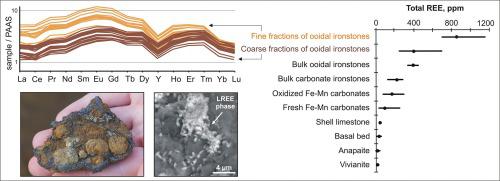当前位置:
X-MOL 学术
›
Ore Geol. Rev.
›
论文详情
Our official English website, www.x-mol.net, welcomes your
feedback! (Note: you will need to create a separate account there.)
Geochemistry and mineralogy of rare earth elements in high-phosphorus ooidal ironstones: A case study of the Kamysh-Burun deposit (Azov–Black Sea iron Province)
Ore Geology Reviews ( IF 3.2 ) Pub Date : 2020-12-01 , DOI: 10.1016/j.oregeorev.2020.103827 Ella V. Sokol , Svetlana N. Kokh , Olga A. Kozmenko , Anna V. Nekipelova , Maxim Rudmin , Pavel V. Khvorov , Dmitry A. Artemyev
Ore Geology Reviews ( IF 3.2 ) Pub Date : 2020-12-01 , DOI: 10.1016/j.oregeorev.2020.103827 Ella V. Sokol , Svetlana N. Kokh , Olga A. Kozmenko , Anna V. Nekipelova , Maxim Rudmin , Pavel V. Khvorov , Dmitry A. Artemyev

|
Abstract This study is aimed at characterizing the distribution and speciation of the rare earth elements and yttrium (REE + Y) in ooidal ironstones from the Kamysh-Burun deposit (Kerch Peninsula), with implications for the depositional environments and contributions of different REE + Y carriers to the ore budget. The Lower Pliocene ooidal ironstone sequence of the so-called Kerch ores, up to 15 m thick, occupies an area of 28 km2. The ore sequence lies between Miocene – Lower Pliocene shell limestones and Upper Pliocene – Pleistocene sandy and clayey sediments and consists of horizontal ooidal ironstone beds composed mainly of goethite and X-ray amorphous Fe3+-(oxy)hydroxides intercalated with siderite and/or rhodochrosite beds. Iron is a main component in ooidal ironstones (50.03–66.19 wt% Fe2O3 and ≤1.61 wt% FeO), as well as in fresh carbonate ores (~34 wt% FeO and ≤14.70 wt% Fe2O3). The Kerch ores contain up to 4.59 wt% P2O5 and show significant positive correlation between P and Fe (r = 0.75). The bulk ore samples and their coarse (1–10 mm) fractions are goethite-dominated and have similar phase, major- and trace-element, and REE compositions. The fine ( La ≈ Nd ≈ Ca > Pr > Sm. The ΣREE content in fresh carbonate ores is below that in PAAS (Xav = 103 ppm), but approaches the latter in oxidized crusts (Xav = 178 ppm). The Kerch ironstones also contain REE-poor early-diagenetic Fe2+ phosphate vivianite (ΣREE Xav = 0.93 ppm) and Ca-Fe2+ phosphate anapaite (ΣREE Xav = 6.95 ppm) with typical seawater REE + Y distributions. The ooidal ironstones show MREE-enriched patterns with distinct negative Y* anomalies, which reveals Fe3+-(oxy)hydroxides as chief carriers of adsorbed REE (mainly MREE). The Kerch ironstones accumulated REE progressively due to hysteretic dissolution and precipitation of Fe3+-(oxy)hydroxides in oscillating redox conditions. The diagenetic source of REE stored in ooidal goethite ironstones was inferred from the PAAS-normalized values: CeN/CeN* vs Nd and CeN/CeN* vs YN/HoN discrimination diagrams. In general, the REE + Y budget of the Kerch ooidal ironstones mainly formed during early diagenesis and scavenging from pore water, with a minor contribution of siliciclastic inputs, in the absence of hydrothermalism.
中文翻译:

高磷鲕粒铁矿石中稀土元素的地球化学和矿物学:以 Kamysh-Burun 矿床(亚速-黑海铁矿区)为例
摘要 本研究旨在表征 Kamysh-Burun 矿床(刻赤半岛)鲕粒铁矿中稀土元素和钇 (REE + Y) 的分布和形态,对不同 REE + Y 的沉积环境和贡献有影响。运营商的矿石预算。所谓的刻赤矿石的下上新世卵形铁岩层序,厚达 15 m,占地 28 平方公里。矿石层序位于中新世 – 下上新世壳灰岩和上新世 – 更新世砂质和粘土沉积物之间,由水平鲕粒铁岩层组成,主要由针铁矿和 X 射线无定形 Fe3+-(氧)氢氧化物组成,中间夹有菱铁矿和/或菱锰矿床. 铁是鲕形铁矿石的主要成分(50.03–66.19 wt% Fe2O3 和≤1.61 wt% FeO),以及新鲜碳酸盐矿石(~34 wt% FeO 和≤14.70 wt% Fe2O3)。Kerch 矿石含有高达 4.59 wt% 的 P2O5,并且 P 和 Fe 之间显示出显着的正相关(r = 0.75)。大块矿石样品及其粗(1-10 毫米)部分以针铁矿为主,具有相似的相、主要和微量元素以及 REE 组成。细粒 (La ≈ Nd ≈ Ca > Pr > Sm。新鲜碳酸盐矿石中的 ΣREE 含量低于 PAAS (Xav = 103 ppm),但在氧化壳中接近后者 (Xav = 178 ppm)。刻赤铁矿也含有贫稀土的早成岩 Fe2+ 磷酸盐紫云母 (ΣREE Xav = 0.93 ppm) 和 Ca-Fe2+ 磷酸盐磷灰石 (ΣREE Xav = 6.95 ppm),具有典型的海水 REE + Y 分布。卵形铁矿石显示出富含 MREE 的模式,具有明显的负 Y *异常,这表明 Fe3+-(氧)氢氧化物是吸附 REE(主要是 MREE)的主要载体。由于 Fe3+-(氧)氢氧化物在振荡氧化还原条件下的滞后溶解和沉淀,刻赤铁矿石逐渐积累了 REE。从 PAAS 归一化值推断出储存在卵形针铁矿中的 REE 的成岩来源:CeN/CeN* 与 Nd 和 CeN/CeN* 与 YN/HoN 鉴别图。总的来说,刻赤鲕粒铁岩的 REE + Y 收支主要形成于早期成岩作用和从孔隙水中清除,在没有热液作用的情况下,硅质碎屑输入的贡献很小。从 PAAS 归一化值推断出储存在卵形针铁矿中的 REE 的成岩来源:CeN/CeN* 与 Nd 和 CeN/CeN* 与 YN/HoN 鉴别图。总的来说,刻赤鲕粒铁岩的 REE + Y 收支主要形成于早期成岩作用和从孔隙水中清除,在没有热液作用的情况下,硅质碎屑输入的贡献很小。从 PAAS 归一化值推断出储存在卵形针铁矿中的 REE 的成岩来源:CeN/CeN* 与 Nd 和 CeN/CeN* 与 YN/HoN 鉴别图。总的来说,刻赤鲕粒铁岩的 REE + Y 收支主要形成于早期成岩作用和从孔隙水中清除,在没有热液作用的情况下,硅质碎屑输入的贡献很小。
更新日期:2020-12-01
中文翻译:

高磷鲕粒铁矿石中稀土元素的地球化学和矿物学:以 Kamysh-Burun 矿床(亚速-黑海铁矿区)为例
摘要 本研究旨在表征 Kamysh-Burun 矿床(刻赤半岛)鲕粒铁矿中稀土元素和钇 (REE + Y) 的分布和形态,对不同 REE + Y 的沉积环境和贡献有影响。运营商的矿石预算。所谓的刻赤矿石的下上新世卵形铁岩层序,厚达 15 m,占地 28 平方公里。矿石层序位于中新世 – 下上新世壳灰岩和上新世 – 更新世砂质和粘土沉积物之间,由水平鲕粒铁岩层组成,主要由针铁矿和 X 射线无定形 Fe3+-(氧)氢氧化物组成,中间夹有菱铁矿和/或菱锰矿床. 铁是鲕形铁矿石的主要成分(50.03–66.19 wt% Fe2O3 和≤1.61 wt% FeO),以及新鲜碳酸盐矿石(~34 wt% FeO 和≤14.70 wt% Fe2O3)。Kerch 矿石含有高达 4.59 wt% 的 P2O5,并且 P 和 Fe 之间显示出显着的正相关(r = 0.75)。大块矿石样品及其粗(1-10 毫米)部分以针铁矿为主,具有相似的相、主要和微量元素以及 REE 组成。细粒 (La ≈ Nd ≈ Ca > Pr > Sm。新鲜碳酸盐矿石中的 ΣREE 含量低于 PAAS (Xav = 103 ppm),但在氧化壳中接近后者 (Xav = 178 ppm)。刻赤铁矿也含有贫稀土的早成岩 Fe2+ 磷酸盐紫云母 (ΣREE Xav = 0.93 ppm) 和 Ca-Fe2+ 磷酸盐磷灰石 (ΣREE Xav = 6.95 ppm),具有典型的海水 REE + Y 分布。卵形铁矿石显示出富含 MREE 的模式,具有明显的负 Y *异常,这表明 Fe3+-(氧)氢氧化物是吸附 REE(主要是 MREE)的主要载体。由于 Fe3+-(氧)氢氧化物在振荡氧化还原条件下的滞后溶解和沉淀,刻赤铁矿石逐渐积累了 REE。从 PAAS 归一化值推断出储存在卵形针铁矿中的 REE 的成岩来源:CeN/CeN* 与 Nd 和 CeN/CeN* 与 YN/HoN 鉴别图。总的来说,刻赤鲕粒铁岩的 REE + Y 收支主要形成于早期成岩作用和从孔隙水中清除,在没有热液作用的情况下,硅质碎屑输入的贡献很小。从 PAAS 归一化值推断出储存在卵形针铁矿中的 REE 的成岩来源:CeN/CeN* 与 Nd 和 CeN/CeN* 与 YN/HoN 鉴别图。总的来说,刻赤鲕粒铁岩的 REE + Y 收支主要形成于早期成岩作用和从孔隙水中清除,在没有热液作用的情况下,硅质碎屑输入的贡献很小。从 PAAS 归一化值推断出储存在卵形针铁矿中的 REE 的成岩来源:CeN/CeN* 与 Nd 和 CeN/CeN* 与 YN/HoN 鉴别图。总的来说,刻赤鲕粒铁岩的 REE + Y 收支主要形成于早期成岩作用和从孔隙水中清除,在没有热液作用的情况下,硅质碎屑输入的贡献很小。











































 京公网安备 11010802027423号
京公网安备 11010802027423号